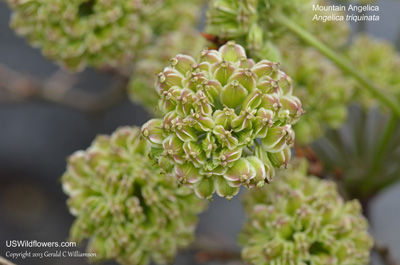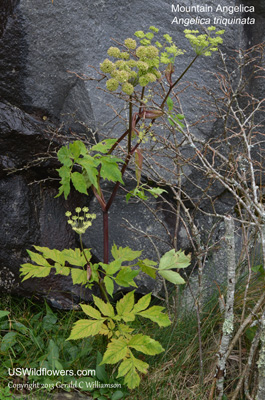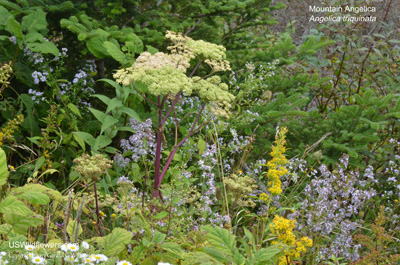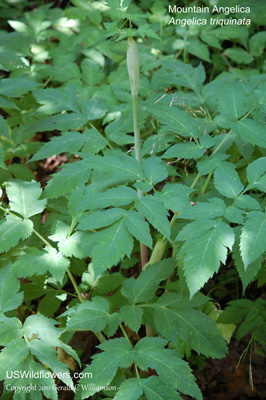Mountain Angelica, Filmy Angelica - Angelica triquinata
|
Angelica triquinata - Mountain Angelica, Filmy Angelica. There are about 24 species of Angelica in the North America, with only 18 of those in the central and western half of the continent. Angelica triquinata - Mountain Angelica - is one of four Angelica species found in the eastern United States (2 are only in eastern Canada). It has a fairly narrow distribution, being found in the Appalachian Mountains from far northeast Georgia up through Pennsylvania. It is Endangered in Kentucky and Maryland.
Of the other eastern species, A. atropurpurea is a more northern species has 20 to 45 umbellets vs 13 to 25 umbellets for A. triquinata, and the acute-tipped leaflets are mostly glabrous, while the acuminate leaflets of A. triquinata have ciliate margins. A. dentata is found only in southwestern Georgia and the panhandle of Florida, and both it and the most widely distributed eastern member of the genus, A. venenosa, have obtuse leaf tips, and A. venenosa is densely pubescent. The species name of this last species speaks to the poisonous nature of the plant; there are also indications that A. triquinata is poisonous, based on the drugged reaction of certain insects to the nectar.
Found in:
GA, KY, MD, NC, PA, SC, TN, VA, WV
Leave comments on Angelica triquinata at this link. | 
Distribution of Angelica triquinata in the United States and Canada:

Blue=Native; Grey=Introduced
Map from USDA Plants Database:
USDA, NRCS. 2017. The PLANTS Database (http://plants.usda.gov, 08 May 2025). National Plant Data Team, Greensboro, NC 27401-4901 USA.
Search Our Database: Enter any portion of the Scientific, Common Name, or both.
Do a general Google search of the entire site:
#ad
 Follow USWildflowers on Twitter
#ad
| | Site: Heintooga Ridge Road (Blue Ridge Parkway spur), Haywood County, NC Date: 2011-August-01 | Photographer: Cindy Williamson
Nikon D40
| | The inflorescence of Angelica triquinata is a compound umbel with 13 to 25 umbellets. The flowers are pale green to greenish white. I have also seen a description of the petals as a greenish yellow; with the other parts of the inflorescence being green, green is the predominant color. | | 
| | Site: GSMNP, Swain County, NC Date: 2013-September-23 | Photographer: Gerald C Williamson
Nikon D7000 | | By late September, when this photo was taken, most of the flowers of Angelica triquinata have changed into developing seeds. The striped seeds are similar in shape to a pumpkin seed, but with winged margins. | | Click on the photo for a larger image

| | Site: GSMNP, Swain County, NC Date: 2013-September-23 | Photographer: Gerald C Williamson
Nikon D7000 | | The stem of Mountain Angelica, especially in the older plants, is frequently red. It is smooth, although those in the inflorescence may be slightly pubescent. | | Click on the photo for a larger image

| | Site: GSMNP, Swain County, NC Date: 2013-September-23 | Photographer: Gerald C Williamson
Nikon D7000
Tamron SP 90MM f/2.8 AF Macro | | At up to 5 or 6 feet tall, Mountain Angelica can grow above its other, beautiful neighbors, here in its native habitat at about 6,000 feet elevation in the Great Smoky Mountains National Park. | | Click on the photo for a larger image

| | Site: Heintooga Ridge Road (Blue Ridge Parkway spur), Haywood County, NC Date: 2011-August-01 | Photographer: Cindy Williamson
Nikon D40 | | The leaves of Angelica triquinata are pinnately or bipinnately compound, with the largest of the leaflets up to 3 inches long. The leaflets are coarsely toothed, and may be lobed. They may have ciliate margins. The foliage structure is similar to, and without the flowers can be mistaken for, other plants that share a similar habitat such as Actaea, Aruncus, and Caulophyllum. At the base of the petioles there are sheaths which partially enclose the stem, and which can be longer the upper leaves. | | Click on the photo for a larger image

|
References used for identification and information:
|
|
| |
| #ad
|
|







